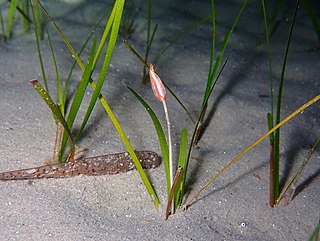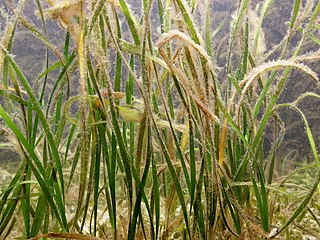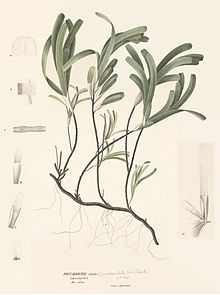
Joseph Marie Henry Alfred Perrier de la Bâthie was a French botanist who specialized in the plants of Madagascar.

Caldesia is a genus of aquatic plants. It includes three living species widespread across Europe, Asia, Africa and Australia. The genus "has an extensive Oligocene through Pleistocene fossil record in Eurasia," and has been found in fossil strata of the United States as well. Ten fossil species have been described for the genus.

Cymodoceaceae is a family of flowering plants, sometimes known as the "manatee-grass family", which includes only marine species.

Helmholtzia is a small genus of flowering plants described in 1866. It includes species native to Australia, Indonesia, and New Guinea.

Barringtonia asiatica is a species of Barringtonia native to mangrove habitats from islands of the Indian Ocean in the west to tropical Asia and islands of the western Pacific Ocean. It is grown along streets for decorative and shade purposes in some parts of India, for instance in some towns on the southeastern shore. It is also known as Box Fruit due to the distinct box-shaped fruit it produces. The local name futu is the source of the name for the Polynesian island Futuna. The type specimen was collected by botanist Pehr Osbeck on a sandy beach area on the island of Java, later to be described by Carl Linnaeus in his Species Plantarum in 1753.

Syringodium is a genus in the family Cymodoceaceae described as a genus in 1860. It is found along shorelines of tropical and subtropical marine environments.

Halodule is a genus of plants in the family Cymodoceaceae described as a genus in 1841. It is widespread on tropical and semi-tropical ocean shores of all continents except Europe and Antarctica.

Cymodocea is a genus in the family Cymodoceaceae described as a genus in 1805. It includes four species of sea grass distributed in warm oceans.
Shafera is a monotypic genus of plants in the groundsel tribe within the sunflower family.
Chandrasekharania is a genus of Indian plants in the grass family.

Sesleria is a genus of perennial plants in the grass family. They are native to Eurasia and North Africa. They are found in Albania, Austria, Baleares, Baltic States, Belarus, Belgium, Bulgaria, Corsica, Czechoslovakia, East Aegean Islands, Finland, France, Germany, Great Britain, Greece, Hungary, Iceland, Iran, Ireland, Italy, Crete, Crimea, Lebanon, Morocco, North Caucasus, Poland, Romania, Sardina, Sicilia, Spain, Sweden, Switzerland, Syria, Transcaucasus, Turkey, Ukraine and Yugoslavia.
Steyermarkochloa is a genus of plants in the grass family. The only known species is Steyermarkochloa angustifolia(Spreng.) Judz., which is native to Colombia (Guainía), Venezuela (Amazonas), and Brazil (Amazonas).
Arthur Francis George Kerr (1877–1942) was an Irish medical doctor. He is known particularly now for his botanical work, which was important for the study of the flora of Thailand.

The World Checklist of Selected Plant Families was an "international collaborative programme that provides the latest peer reviewed and published opinions on the accepted scientific names and synonyms of selected plant families." Maintained by the Royal Botanic Gardens, Kew, it was available online, allowing searches for the names of families, genera and species, as well as the ability to create checklists.

Halodule wrightii is an aquatic plant in the Cymodoceaceae family. It is referred to by the common names shoal grass or shoalweed, and is a plant species native to seacoasts of some of the warmer oceans of the world.

Blyxa is a genus of an aquatic plant of the family Hydrocharitaceae described as a genus in 1806.

Thalassodendron ciliatum, the sickle-leaved cymodocea, is a species of plant in the Thalassodendron genus of seagrasses in the family Cymodoceaceae.
Zostera tasmanica is a species of marine eelgrass in the Zosteraceae family. It is native to the seacoasts of Tasmania, New South Wales, Victoria, South Australia, and Western Australia.
× Aegilotriticum is a nothogenus of flowering plants in the family Poaceae. They are the result of crosses between species of two distinct grass genera, Aegilops (goatgrasses) and Triticum (wheat). This type of intergeneric hybridization is quite rare, and is indicated by a multiplication symbol before the name. The name Aegilotriticum is an example of a portmanteau word, a combination of the two parents' names. This genus has at least 7 species.
Periclesia is a monotypic genus of flowering plants belonging to the family Ericaceae. It only contains one known species, Periclesia flexuosaA.C.Sm. It is also with the Vaccinioideae subfamily and the Vaccinieae tribe.












